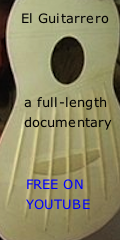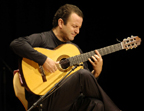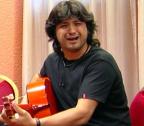Welcome to one of the most active flamenco sites on the Internet. Guests can read most posts but if you want to participate click here to register.
This site is dedicated to the memory of Paco de Lucía, Ron Mitchell, Guy Williams, Linda Elvira, Philip John Lee, Craig Eros, Ben Woods, David Serva and Tom Blackshear who went ahead of us.
We receive 12,200 visitors a month from 200 countries and 1.7 million page impressions a year. To advertise on this site please contact us.
|

|
|
RE: Flamenco Circle of Fifths (RE: Flamenco Keys)
|
You are logged in as Guest
|
|
Users viewing this topic: none
|
|
Login  | |
|

   
Ricardo
Posts: 14801
Joined: Dec. 14 2004
From: Washington DC

|
 RE: Flamenco Circle of Fifths (RE: F... (in reply to joevidetto) RE: Flamenco Circle of Fifths (RE: F... (in reply to joevidetto)
|
|
|
quote:
You've got a lot of credibility in my book Ricardo, but on this point - how often is what you refer to really done ? I'd love to hear the example you're referring to, and 3 or 4 more - because if they're doing what they say you are doing, I'd love to hear more and learn how they approach finding these types of improvisation passages (or compositions more likely)
Hey joe, you are replying to me, but quoting Burdo...and like you, I would love to hear that example. I suspect this is subjective about it sounding cool. Dissonance does not always mean “out of key”. But it does remind of the joke about jazz “just play all the wrong notes as fast as possible”. 
I am often frustrated trying to explain clearly what I am talking about when people reply with odd guitar speak revealing to me they weren’t really following. I think it whittles down to MINOR KEYS and how they operate differently than major keys. I think a lot of guitar players think Aeolian jams and minor keys are the exact same thing, and sometimes that exotic fully diminished7 you mentioned comes in for flavor, or not it’s all the same. I really don’t see it that way, it is much more black and white to me. If the people I am trying to translate flamenco concepts to already understand minor keys and tonal funciton, then I have a basis of how to move forward with how flamenco is similar and different to minor keys. What I often end up with is people that understand modes and jazz somewhat and cant’ get into “tonal function mind set”, even if they sort of understand ii-V-I. Blues jazz and rock operate differently, and it is a lot of “we don’t follow classic music rules here”, but that is not the point...it is not about “rules” it is about what a basic view of circle of 5ths shows is the scope of music on equal tempered instruments. Nothing in Rock or jazz is so innovative it violates the basic system at work.
Coming back to your diminished trick (you meant fully diminished7th, as there are two other types, half diminished, and diminished major7), the reason it works is simple. Spelling. If you spell the thing wrong on purpose you can use it as a device to move to other territories. Enharmonic misspelling is a fun trick jazz discipline uses to move around the wheel more freely. It is not complicated, but you can only use 7 letter names at a time. But right there a lot of guitar players are like “wow, too much theory for me!!!”. To explain what a simple scale implies I feel like I need to get super wordy to be crystal clear. I have restated countless times, the circle of 5ths contains all the logic about everything going on. If something doesn’t fit, then it is a spelling issue, it is real simple.
_____________________________
CD's and transcriptions available here:
www.ricardomarlow.com
|
|
|
|
REPORT THIS POST AS INAPPROPRIATE |
Date Feb. 7 2021 18:08:00
 |
|

   
Ricardo
Posts: 14801
Joined: Dec. 14 2004
From: Washington DC

|
 RE: Flamenco Circle of Fifths (RE: F... (in reply to El Burdo) RE: Flamenco Circle of Fifths (RE: F... (in reply to El Burdo)
|
|
|
quote:
You mention tricks: one nice mm trick on a minor ii V i is play the ø arpeggio on the ii, then play the same shape a m3rd up for the altered dominant, then play the same shape a further M3rd up for the i (getting the M7th). Similar to the diminished 7 'steam engine over damsel tied to the rails' trick but with harmonic movement.
Sorry I only added the Bach thing to the previous post (I was looking for some chromatic piano that showed a similar dissonance that resolves to consonant place but was more deliberately “tonal”.). It is NOT the same of course, that’s why I wanted to show it as more “tonal” concept. Though a similar idea of tension and release is at play.
Yes I forgot to mention that the two mm modes I described are the same scale a minor third apart. (2-5–1 in C means F melodic then Ab melodic and yes C is a major 3rd up from that.). So one could potentially play the same phrase, scalar or arpegio, and move it up 3 frets. Anyway after going through his course I did start noticing the fun stuff happening on the 2 chords in jazz.
About flamenco key system. I feel I need something as a musical reference outside of pure flamenco in order to justify the concept. I am still sort of searching for such a thing but my research tells me I am pretty close. The reason it is important is because if the only musical examples are flamenco itself, it can be argued for a prejudice in favor of something that is too specific. As I have stated over and over, it is not easy to justify Solea/fandango in E phrygian as legitimate distinct “key” from A minor proper. Anything I might say about it can be scrubbed in favor of “half cadence” by a good musician unfamiliar with flamenco compas. What has been going on in literature is folks are cool with “modes” from a rock/jazz guitar perspective and feel that is sufficient to explain flamenco. We have already seen that most of us can tell the different between “fakemenco” vs what actually goes on in andalucia. Andalusian cadence serves nothing more than point back to minor key function. Since I can barely convince you guys that actually know about flamenco and importantly COMPAS, what the heck I am talking about, then you need to wait until I can get some concrete thing that can be analyzed correctly from NON flamenco people, as representative of the same thing we have going on.
_____________________________
CD's and transcriptions available here:
www.ricardomarlow.com
|
|
|
|
REPORT THIS POST AS INAPPROPRIATE |
Date Feb. 8 2021 16:52:05
 |
|

   
Ricardo
Posts: 14801
Joined: Dec. 14 2004
From: Washington DC

|
 RE: Flamenco Circle of Fifths (RE: F... (in reply to El Burdo) RE: Flamenco Circle of Fifths (RE: F... (in reply to El Burdo)
|
|
|
quote:
Well, this is certainly a fertile direction (as you have all been discussing)...wikiquote:The harmonic minor is also occasionally referred to as the Mohammedan scale...commonly found in Middle Eastern music. The harmonic minor scale as a whole is called Nahawand[6] in Arabic nomenclature, as Bûselik Hicaz[7] in Turkish nomenclature, and as an Indian raga, it is called Keeravani/Kirwani...
As I said before, non tempered, non funcional ie non useful/false equivalence.
I thought it was clear the concrete example I need has to be equal tempered basically, and functional western instrument oriented. For Example that ca 1800 harpsichord “fandango” score was ALMOST the perfect example I could have used to illustrate my point. However when I examined it closer it doesn’t really work for our purposes, it is simply “minor key” piece using half cadence. We deliberately avoid that device in flamenco today. To make that work I would have to alter all the guys d minor chords, and I dont’’ want to do that. I intend to find SOMETHING man, and I will I promise, and when I do I will write out the thing crystal clear.
_____________________________
CD's and transcriptions available here:
www.ricardomarlow.com
|
|
|
|
REPORT THIS POST AS INAPPROPRIATE |
Date Feb. 8 2021 20:12:23
 |
|

   
Sr. Martins
Posts: 3077
Joined: Apr. 4 2011

|
 RE: Flamenco Circle of Fifths (RE: F... (in reply to Ricardo) RE: Flamenco Circle of Fifths (RE: F... (in reply to Ricardo)
|
|
|
Ah, nice.. I am not the only one with crazy hearing hehe
On phrygian and flamenco I can hear weird too. For instance, the inverted Bb chord for me keeps sounding as a Dmin with a raised 5th...it's like my mind puts it as a D, going to C, down to Bb and A.
Bb's also sound dominant, although modally as a degree it would be Lydian. It just sounds like it, maybe idiomatically, wants to resolve a half step below. It even sounds great with added tension, just like a dominant would.
Really like this Bb:
x
3
3
3
x
4
Tension note on the bass that ends up making it a "true dominant" that still resolves a half step back. Well, looking at it now, maybe with this particular one it's just some a tri tone sub which I hadn't thought of before.. ok, carry on with the lessons.
_____________________________
"Ya no me conoce el sol, porque yo duermo de dia"
|
|
|
|
REPORT THIS POST AS INAPPROPRIATE |
Date Feb. 8 2021 20:42:24
 |
|
 New Messages New Messages |
 No New Messages No New Messages |
 Hot Topic w/ New Messages Hot Topic w/ New Messages |
 Hot Topic w/o New Messages Hot Topic w/o New Messages |
 Locked w/ New Messages Locked w/ New Messages |
 Locked w/o New Messages Locked w/o New Messages |
|
 Post New Thread
Post New Thread
 Reply to Message
Reply to Message
 Post New Poll
Post New Poll
 Submit Vote
Submit Vote
 Delete My Own Post
Delete My Own Post
 Delete My Own Thread
Delete My Own Thread
 Rate Posts
Rate Posts
|
|
|
Forum Software powered by ASP Playground Advanced Edition 2.0.5
Copyright © 2000 - 2003 ASPPlayground.NET |
0.09375 secs.
|


 Printable Version
Printable Version









 New Messages
New Messages No New Messages
No New Messages Hot Topic w/ New Messages
Hot Topic w/ New Messages Hot Topic w/o New Messages
Hot Topic w/o New Messages Locked w/ New Messages
Locked w/ New Messages Locked w/o New Messages
Locked w/o New Messages Post New Thread
Post New Thread